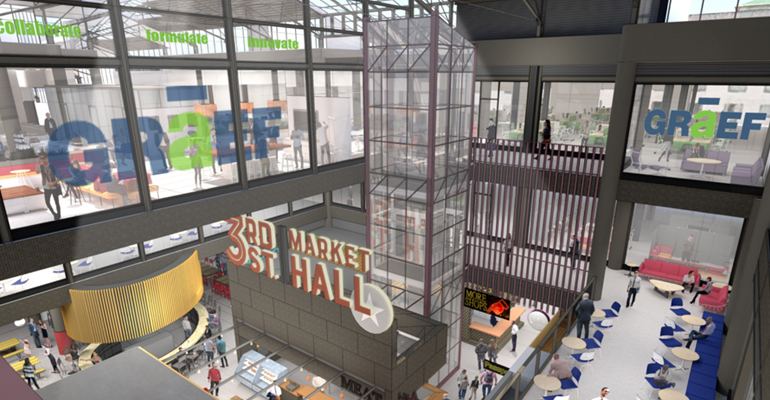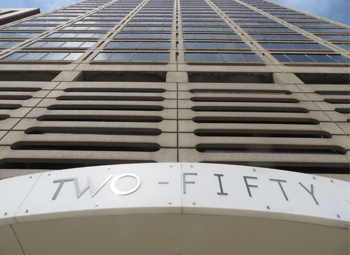It was just over two years ago that Bader Rutter moved from Brookfield into its new downtown Milwaukee office space.
The marketing firm made the decision to move from the Bishop’s Woods office park into a brand new mixed-use development located along the Milwaukee River at the former Laacke & Joys site, 1433 N. Water St.
Company executives say now that they’ve been in their new offices a while, they have become ad hoc advisors to a number of other companies also looking to join them in downtown Milwaukee.
Of course, they said, they love to share their experiences and give advice to those firms.
“There’s no question that the location has allowed us to achieve our vision,” Greg Nickerson, Bader Rutter chairman, said of the choice to move downtown. “Without the river, without the street, without being on the first three floors, we couldn’t have pulled off what we wanted to.”
And what was it, exactly, that they wanted to pull off? Selecting a location that would, among other things, serve as a way to help the company recruit talented workers and keep them there. If your company is planning to move its operations to a new location, you may need the services of an office moving company to help transport all of your office equipment, documents and supplies.
Bader Rutter is just one of a number of companies that have in recent years decided to relocate their offices closer to the heart of the city. Although the explanations for each move vary by company, the objective of hiring the best workers is a common refrain.
Who’s moving?
The companies that have recently chosen to move either their headquarters or regional offices downtown include:
Real estate developer Hammes Co. is putting the final touches on a new five-story headquarters building at the corner of North Water and East Knapp streets, where it occupies 34,000 square feet over two floors and is leasing the remaining space to other office tenants
WageWorks Inc., a California-based administrator of consumer-directed benefits, in 2018 moved its area offices from Mequon into the top two floors of the CityCenter at 735, renovating 35,000 square feet of office space at the building at 735 N. Water St.
Janesville-based contractor J.P. Cullen & Sons Inc. last year relocated its Brookfield office to the Milwaukee Fortress Building, just north of Schlitz Park near downtown, moving its 40 to 50 employees into roughly 13,000 square feet on the first floor of the recently redeveloped building.

Dallas-based Jacobs Engineering Group Inc. has moved its Milwaukee offices from Honey Creek Corporate Center on the city’s west side to Schlitz Park, where the group’s 200-plus area employees take up 14,650 square feet of space.
Kansas City-based engineering firm HNTB Corp. this summer will move its Milwaukee office from the Park Place office park on Milwaukee’s far northwest side into a 25,000-square-foot space in the Two-Fifty building at 250 E. Wisconsin Ave.
Milwaukee-based engineering firm GRAEF-USA Inc. is planning to move its headquarters out of Honey Creek and into a brand-new, 35,000-square-foot space on the third floor of The Avenue mixed-use development at North Old World Third Street and West Wisconsin Avenue sometime in late 2019.
Rexnord Corp. plans to move operations into the office complex at 105-111 W. Michigan St., according to sources. The company has not publicly confirmed its interest in the building, nor has it detailed how much space it would be leasing or how many employees would move into the office. The building was recently purchased by 111 Michigan Partners LLC and is undergoing renovations.
A number of these companies have identified the need to attract and retain skilled workers as a key reason for selecting a new office downtown. Mark Kaminski, vice president of HNTB, said it was in the “top tier of elements we considered” when seeking out a new office space.
“We want to make sure we’re offering (employees) an exciting location to work, an exciting location to stay,” Kaminski said.
Choosing a location that inspires
Steve Pape, principal and office broker at Founders 3 Real Estate Services LLC, said over the past five years, he has seen more companies view their offices as a recruitment tool.
“Companies are recognizing the days of employees spending 10 to 20 years with the same company are few and far between,” he said.
With a healthy economy, people are no longer hard-pressed to find a job. U.S. unemployment is at 3.6%, and in Wisconsin the unemployment rate is just under 3%. Those low unemployment rates indicate a tough market for companies to find employees.
Some industries, especially those that require a workforce with highly specified skillsets, are having an even more difficult time than others in finding enough qualified employees.
Lori Rosenthal, vice president and principal with GRAEF, said her firm has gotten creative in bringing in enough talented workers, such as acquiring smaller firms and bringing in an entire group of new employees, rather than one at a time. The company also views its new office space at The Avenue as an important part of those efforts.
“We see The Avenue not as primarily a decision for where we are now, but The Avenue is a decision for what we think our future employees are going to be about and want,” Rosenthal said. “So, it’s also part of that employee package and experience that we think is important for recruitment and retention.”
The Avenue development represents the reimagining of the former Shops of Grand Avenue just west of the Milwaukee River. The project will dramatically shrink the size of retail space at the mall to offer a larger mix of uses, including 190,000 square feet of office space; the 3rd Street Market Hall, a 21-tenant, 35,000-square-foot food hall on the ground floor; and the 52-unit Plankinton Clover apartment complex. It will also offer amenities such as a fitness club, an event center and a tenant lounge.
Tony Janowiec, co-owner of The Avenue, said the decision to add office space at The Avenue development came after the project team evaluated both what could feasibly be done with the building and what was needed in the market. He said there was particularly a clear need in the downtown area for large-format office space on a single level.
“We evaluated the intersection of what we felt there was demand for in the market, plus what areas of the building could actually be used for other than the historical retail use,” he said.
The Avenue checked a lot of GRAEF’s boxes in what the firm was looking for, such as the ability to house all employees on a single floor, easy access to the freeway, ample parking and a cheaper overall price than what they were paying – which was in part achieved by shrinking the square footage the firm was leasing.
One thing that set it apart, though, was all the energy surrounding it.
“To be honest, there just was a lot of buzz after being through The Avenue,” Rosenthal said. “The space, when we saw it, looked like it did when it was shuttered. … But still, you could see the beauty of this raw space and everybody just came back very excited.”
John Kissinger, president and chief executive officer of GRAEF, said when the firm was first pitched The Avenue as an office location, he didn’t think much about it. Now, he knows the firm made the correct choice to move downtown, given the number of competing firms that have announced they would do the same in recent months.
“The Avenue really sold us on their vision, the vision of transforming this old mall into an office,” he said.
Similar to GRAEF, Bader Rutter executives were attracted to downtown due to its energy, as well as the promise of new developments such as the Fiserv Forum. Jeff Young, president and CEO of Bader Rutter, said this was a “tipping factor” in making their choice.
“As we were pondering staying out west, we would look at sites, then we would come down here and look at sites,” he said. “Greg and I would talk and we’d go, ‘We’re sort of deluding ourselves if we somehow could create the energy that you could get down here — we’re on the river, we’re on Water Street — that we could recreate that energy in the ’burbs.’ … There really was no comparison.”
Nickerson said it’s important that his company and others attract talent from beyond the Milwaukee area, including nearby urban areas like the Twin Cities and even the coastal U.S. This benefits not only the company but the entire Milwaukee community, as it draws in more talented employees that otherwise wouldn’t be here.
The company’s new office has helped in those efforts. Bader Rutter noted it has seen a 40% increase in traditional applications – such as through its electronic system as opposed to things like word-of-mouth and referrals – between 2016, when it was located in Brookfield, and 2018.
At HNTB, Kaminski said his firm started out the office hunt by looking at over a dozen places throughout the city.
“It wasn’t too long before the properties and assets we were looking at, all the top ones were (in) the downtown area,” he said.
The Two-Fifty building attracted HNTB with access to nearby transportation and transit networks, such as bus lines, The Hop streetcar system and the interstate. Its proximity to the Milwaukee Public Market in the Historic Third Ward, restaurants and the Fiserv Forum and related entertainment offerings also played a role.
“For us, we wanted to make sure from an accessibility standpoint that whatever location we chose was easy to access for both our employees and our clients,” he said.
Kaminski was careful to point out that the firm’s decision to move isn’t a reaction to the challenge of finding enough talented workers. Rather, HNTB views its new office as a tool to continue its success in attracting and retaining employees.
Urbanization on the upswing
Bill Bonifas, executive vice president and office broker at CBRE’s Milwaukee office, said like any broader trend, the shifting of companies from the suburbs to downtown (and vice versa) seem to have their own lifecycle.
He noted that when he first started in the business, most of the office market was focused downtown. What began the overall movement to the suburbs, he said, were the freeways that were built around the 1960s. The interstate system allowed people to quickly travel to the far reaches of the metro area, and it meant companies did not have to settle for older, vertical buildings with smaller floor plates.

Courtesy Kubala Washatko Architects
“A lot of these were built when they had to go vertical due to transportation issues,” Bonifas said. “So it was embracing the modern, going to the suburbs and taking the freeways, which was this new and exciting thing.”
Bonifas said the larger buildings and cheap development costs drove “millions of square feet” to the suburbs.
But now, the migration back toward urban environments is occurring due to a number of factors. Bonifas said the younger generations typically have more of a taste for urban areas, perhaps because more of them have been exposed through their personal experiences or through traveling. Then there was the apartment boom, which brought more people toward the city’s center – again, with many of them being younger.
Bonifas pinpoints the start of office users moving back downtown around 2003, with Roundy’s Inc. moving from Pewaukee to 875 E. Wisconsin Ave. and bringing with it about 500 employees. Then in 2007, ManpowerGroup moved about 900 employees from Glendale to its new headquarters at Schlitz Park.
“It’s more exciting and vibrant for most employees, so I think we’re going to continue to see this trend in the future,” Bonifas said of downtown.
More offices on the horizon

As more companies look toward downtown, they will have more choices for new office spaces.
For instance, Milwaukee-based Irgens Partners LLC is securing tenants for the new BMO Tower under construction at the corner of North Water and East Wells streets. The 25-story glass office building is expected to be finished at the end of this year. Accounting for the leases that have already been announced, about 160,000 square feet of the roughly 360,700 square feet of office space is still available in the tower.
Milwaukee developer J. Jeffers & Co. plans to build an 11-story office building, called The Huron Building, at 511 N. Broadway downtown. The building will be anchored by the Husch Blackwell law firm’s Milwaukee office.
However, additional developments promise to add hundreds of thousands of square feet of additional office space on the west side of the Milwaukee River. This includes The Avenue project, though that space is likely to fill quickly, according to the project developers.
Janowiec said once GRAEF moves into its offices there will technically be about 115,000 square feet of office space available. But, he added, about 80% of that space has potential tenants at some stage of the letter of intent process. Janowiec said he’s spoken with a range of possible tenants, including a creative firm, a marketing firm and a national coworking firm.
“It’s really quite a diverse array of businesses that we’re negotiating with,” he said.
The Milwaukee Bucks also recently unveiled conceptual plans for the remaining developable sites of its eight-block Deer District. Centered around the new Fiserv Forum arena, the area already includes developments such as an entertainment block, the team’s training center with an attached clinic, a parking structure and an in-progress apartment complex. The remaining undeveloped blocks are envisioned to include a mix of uses, such as retail, residential, hospitality and, of course, offices.
In fact, marketing brochures depict 242,500 square feet of office space for the block north of the arena and east of the parking structure. The new office development could be completed by April 2021, depending on preleasing activity.
Gauging the market

By the estimation of Brandon Frankel, market analyst with CoStar Group Inc., the downtown market is performing well relative to what’s typical for the area.
Specifically for the downtown east area, which includes the primary central business district of downtown Milwaukee, office vacancies are at about 8.5%, he said. This rate “would be healthy by almost every standard, but especially healthy that downtown east averages 9.8% historically,” Frankel said.
Class A office space vacancies are at 10.7% in the downtown east submarket, a little higher than all office space in the market, he added. This, said Frankel, is primarily because of the new construction activity in the area, such as the 833 East building at 833 E. Michigan St. and the upcoming BMO Tower.
Rent growth, meanwhile, has softened after a strong five-year period. From 2013 through the end of 2017, rent growth in the downtown east submarket was never below 1.3%, with the market historically seeing about 1.5% growth per year. In 2018, however, the market saw less than 1% rent growth.
With that in mind, Frankel said the development community in Milwaukee appears to have done a nice job balancing new supply with expected demand.
However, one other thing to be aware of, he said, is that job growth among office users in the downtown east submarket was negative in 2018. This is not a positive sign for future office absorption rates, since it directly correlates with office-using job growth.
Beyond location
To be sure, the new glass towers downtown turn a lot of heads. But many of the recent moves – Jacobs Engineering leasing space at the redeveloped Schlitz Park, HNTB moving into the renovated Two-Fifty and GRAEF committing to a redeveloped former shopping mall – involve buildings that have been recently updated or converted into Class A office space, Pape said.
With such buildings, companies can enjoy lower rental costs. Parking also often plays an important role, as is the case with GRAEF.
Location is certainly important when companies consider an office space that will win over employees, but it’s not the only thing, Pape said. The most important aspect, in fact, may be the amenities that the building and surrounding area offer workers.
Pape said he sees more office buildings that are beginning to offer things like coffee bars, tenant lounges, fitness centers and coworking spaces. These provide workers with the opportunity to “vary their work environment outside of their four walls.”
This means downtown isn’t the only place that can offer an office environment that serves as a means to attract talented employees.
Pape said good examples of amenity-rich office environments outside of downtown include Summit Place office complex in West Allis (the end result of a $50 million transformation of a former Allis-Chalmers site in 2004) and the Milwaukee County Research Park in Wauwatosa, which boasts tenants like GE Healthcare and Fujifilm, as well as young startup companies.
Even so, he said it’s clear many younger workers are seeking out a job that has them working in “cool, urban environments.” This gives downtown an advantage in the location decision-making process as companies are factoring in everything from rental costs to building amenities to location.
Beyond that, attracting talent still remains just one factor in choosing the right office environment.
Bonifas said he views the urbanization of office spaces as one of several key trends in the office market. Among the other important trends is that companies are seeking out offices that have an interesting aesthetic, meaning design is more important than ever.
“It’s a look and feel that elevates and is aesthetically interesting, however defined by the people,” such as the choice between concrete floors or interesting carpet patterns, he said. As a result of this emphasis, the cost of tenant improvements is on the rise.
Similarly, companies are placing more emphasis on office views and natural light. They are also more sensitive to environmental issues than in the past, and seek out environmentally friendly buildings with LEED certification.
Beyond the office itself, companies are now placing more emphasis on technology, Bonifas said. Employers, he said, want their people to be able to work from places other than just their desks, whether that be in collaboration areas, from home or even at a coffee shop.
Making the change
When discussing Bader Rutter’s move with other companies, Nickerson and Young said they get a lot of questions about how they handled everything from managing the transition to making sure employees were on board.
Nickerson said some employees expressed concerns about working downtown at first, ranging from parking, to the commute, to potential crime.
What Nickerson and Young said they can tell others, though, is that they can count on one hand the number of people they lost directly due to the move downtown. And now, Bader Rutter is seeing employees more interested and engaged in the community than they had been in the suburbs, they said. Bader Rutter is also seeing more opportunities to form meaningful relationships with area organizations and universities.
“There’s not an absolute formula that you can plug into this (decision),” Nickerson said. “Ultimately you’re going to go with your gut telling you that if you look at all these things, that this is right for your business. Because it is a big investment of time, energy and most cases, dollars, but also there’s a disruption to the business.”
In the two years since making the move downtown, Nickerson said he has not looked back and regretted the decision.





